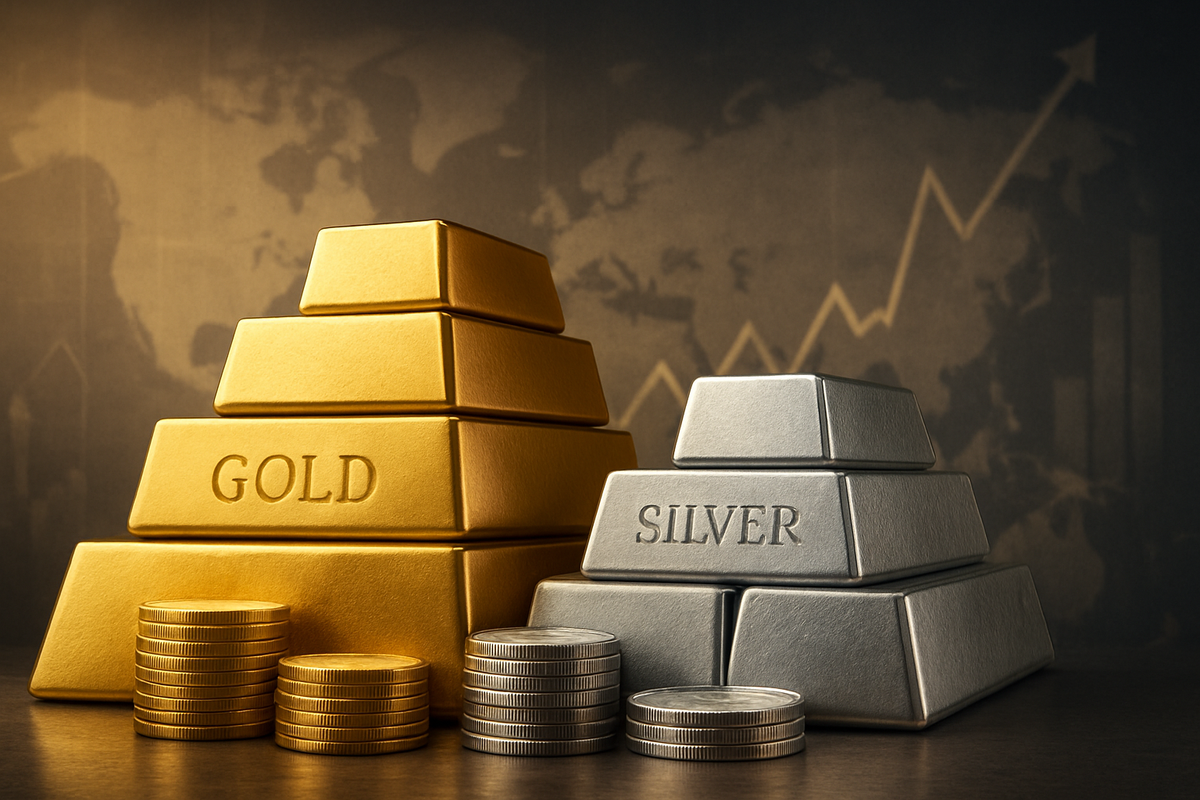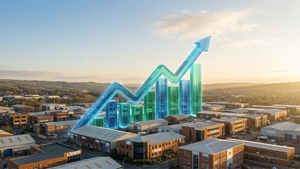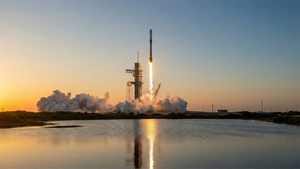
The global financial landscape is witnessing a seismic shift as gold and silver have surged to historic all-time highs in 2025. This monumental rally, fueled by an intricate web of geopolitical tensions, persistent inflationary pressures, and a dovish shift in monetary policies, has sent ripples across markets, compelling investors to fundamentally re-evaluate their portfolios. With gold touching near $4,400 per ounce and silver eclipsing $54 per ounce in October, the precious metals are reasserting their traditional role as critical safe-haven assets, signalling a profound crisis of confidence in conventional financial instruments.
This unprecedented ascent carries immediate and far-reaching implications. Market participants are increasingly diverting capital from other asset classes, seeking the tangible security offered by gold and silver amidst an environment of heightened economic uncertainty and currency debasement concerns. The rally underscores a broader sentiment of caution, as investors grapple with a complex interplay of factors that continue to reshape the global economic order.
A Historic Ascent: Unpacking the Precious Metals' Record Run
The year 2025 has been nothing short of extraordinary for precious metals. Gold (XAU) reached an astounding all-time high of $4,381.58 per ounce in October, briefly touching levels near $4,400, following a relentless climb from approximately $3,300 during the summer months. As of early November 2025, the yellow metal has consolidated, trading resiliently around the $4,000 threshold, maintaining a staggering 45.34% year-over-year gain and an impressive 50% year-to-date advance through late October.
Silver (XAG), often dubbed "poor man's gold," has mirrored this spectacular performance, reaching a 14-year high of $44.55 per ounce by September and an all-time high of $54.49 per ounce in October 2025. While experiencing some profit-taking and retreating slightly below $49.00, silver currently trades between $47 and $49 per ounce in early November, still boasting a remarkable 43.79% increase over the past year and a 66% year-to-date surge through late October. This dual surge marks a significant moment, with both metals demonstrating robust strength even amidst periods of short-term volatility.
The timeline leading to these historic highs is marked by several critical developments. Throughout 2025, the Federal Reserve's accommodative monetary policy, including interest rate cuts in September and October, has significantly reduced the opportunity cost of holding non-yielding assets. Concurrently, escalating geopolitical tensions—ranging from the protracted Russia-Ukraine conflict and Middle East instability to renewed US-China trade disputes and a prolonged US government shutdown—have intensified safe-haven demand. Key players include central banks globally, which are accumulating gold at a record pace (projected 750-900 tonnes in 2025) as a strategic hedge against de-dollarization and asset seizure concerns. Initial market reactions have seen a potent flight to safety, with a surge in first-time gold investing sentiment echoing levels typically observed during extreme crisis events.
Despite a recent strengthening of the US dollar and rising US Treasury note yields (the 10-year T-note yield climbing to 4.11% on November 3, 2025), gold has shown remarkable resilience, maintaining its upward trajectory. This suggests that the underlying drivers of the rally are powerful enough to counteract traditional headwinds, indicating a deeper, systemic shift in investor preferences towards tangible assets.
Corporate Fortunes: Winners and Losers in the Precious Metals Boom
The unprecedented surge in gold and silver prices is creating a clear bifurcation in the corporate landscape, ushering in a new era of prosperity for some while posing significant challenges for others. Companies directly involved in the extraction, processing, and investment of precious metals are poised to be the primary beneficiaries, experiencing substantial boosts to their revenues, profits, and market valuations.
Mining companies, particularly those with significant gold and silver operations, are seeing their profit margins expand dramatically. For instance, Barrick Gold Corp. (NYSE: GOLD) and Newmont Corporation (NYSE: NEM), two of the world's largest gold producers, are likely to report record earnings, driven by higher realized prices for their output. Similarly, silver-focused miners like Pan American Silver Corp. (NASDAQ: PAAS) and Wheaton Precious Metals Corp. (NYSE: WPM), a prominent silver and gold streaming company, are benefiting immensely from the elevated price of silver and robust industrial demand, particularly from the burgeoning green energy sector. These companies can leverage increased cash flows to reduce debt, expand exploration efforts, or return capital to shareholders through dividends and buybacks, making them attractive prospects for investors seeking exposure to the precious metals rally.
Conversely, companies that rely heavily on precious metals as inputs, such as certain jewelry manufacturers or industrial users without adequate hedging strategies, could face increased cost pressures. While not directly "losers" in the same vein as those facing declining demand, their profitability might be squeezed if they cannot pass on higher raw material costs to consumers. Furthermore, financial institutions and investment funds that were underweight in precious metals or heavily exposed to traditional fixed-income assets that have underperformed in this environment might find themselves lagging behind. The rally could also indirectly impact sectors that thrive on market stability and lower volatility, as capital shifts towards safe-haven assets.
The rise in precious metals has also significantly boosted investment vehicles tied to gold and silver. Exchange-Traded Funds (ETFs) such as SPDR Gold Shares (NYSEARCA: GLD) and iShares Silver Trust (NYSEARCA: SLV) have seen massive inflows, reflecting robust investor demand. Mining ETFs, in particular, have delivered over 100% returns, highlighting the substantial opportunities for companies within the precious metals ecosystem. This re-rating of precious metal-related assets indicates a broader market acknowledgment of their enhanced role in diversified portfolios during times of economic uncertainty.
Broader Implications: A Shift in the Global Financial Paradigm
The historic surge in gold and silver prices extends far beyond immediate market fluctuations, signaling a profound recalibration of global financial dynamics. This event is not an isolated incident but rather fits squarely into broader industry trends emphasizing tangible assets and risk aversion. The persistent rally underscores a growing skepticism towards fiat currencies and sovereign debt, particularly in an environment where major central banks, including the Federal Reserve, are pursuing accommodative monetary policies and engaging in sustained rate cuts, leading to negative real interest rates. This environment inherently diminishes the appeal of holding non-yielding cash or low-yield bonds, making gold and silver increasingly attractive as stores of value.
The ripple effects of this surge are multifaceted. Competitors in the broader commodities market may experience shifts in capital allocation, as investors prioritize the perceived safety and upside potential of precious metals. Partners in the supply chain, from exploration and mining services to refiners and distributors, are experiencing increased demand and profitability. Critically, the aggressive accumulation of gold by central banks globally—driven by concerns over asset seizures and a strategic pivot towards de-dollarization—represents a significant geopolitical and economic trend. This collective action by nations to diversify away from traditional reserve currencies like the US dollar has profound implications for the international monetary system, potentially accelerating a move towards a more multipolar financial order.
Regulatory and policy implications are also emerging. Governments and financial authorities may face increasing pressure to address the underlying causes of market instability and inflation that are fueling this flight to safety. Debates around monetary policy frameworks, fiscal responsibility, and international trade relations are likely to intensify. Historically, periods of significant precious metals appreciation have often coincided with major economic or geopolitical dislocations. For instance, the gold bull markets of the 1970s and early 2000s were both characterized by high inflation, geopolitical turmoil, and a loss of confidence in prevailing economic paradigms. The current environment, with its unique blend of monetary easing, supply chain disruptions, and widespread geopolitical conflicts, draws striking parallels, suggesting that the current rally is not merely speculative but fundamentally driven by systemic concerns.
This sustained performance of gold and silver, even amidst a temporarily strengthening dollar, indicates a structural shift where the intrinsic value and safe-haven properties of these metals are outweighing traditional market dynamics. It suggests a deeper crisis of confidence in the established financial order, compelling a re-evaluation of how wealth is preserved and grown in an increasingly uncertain world.
The Road Ahead: Navigating the Future of Precious Metals
Looking ahead, the trajectory for gold and silver in 2025 and beyond appears robust, albeit with potential short-term volatility. The current environment strongly suggests that the precious metals bull market is in its early to mid-stages, with significant upside potential. For gold, analysts are eyeing a target of $4,400 per ounce as a realistic possibility for 2025, a level briefly touched in October 2025, indicating strong underlying momentum. Silver is similarly projected to reach $54 per ounce, also having seen this level in October, propelled by both safe-haven demand and burgeoning industrial applications, particularly in the clean energy sector.
Several key economic drivers are expected to sustain this momentum. Continued accommodative monetary policies from central banks globally, coupled with persistent inflationary pressures, will likely keep real interest rates negative, reducing the opportunity cost of holding non-yielding precious metals. Geopolitical instability, including ongoing conflicts and trade disputes, will continue to fuel safe-haven demand. Furthermore, the sustained trend of central bank gold accumulation is a powerful structural tailwind, indicating a long-term strategic shift away from dollar dominance.
Potential strategic pivots for investors include maintaining a significant allocation to precious metals as a hedge against currency debasement and market volatility. Mining companies may focus on expanding production, exploring new deposits, and optimizing operational efficiencies to capitalize on higher prices. Market opportunities will emerge in junior mining companies with promising exploration projects, as well as in innovative financial products that offer diversified exposure to the precious metals complex. Challenges could include periods of profit-taking, particularly if there are temporary de-escalations in geopolitical tensions or unexpected shifts in central bank rhetoric. However, the overarching macroeconomic and geopolitical landscape suggests these will likely be temporary corrections within a broader uptrend.
Potential scenarios range from a continued steady ascent, driven by the current macro trends, to more accelerated gains if global instability intensifies or if inflation proves more intractable than anticipated. A less likely scenario would be a sharp reversal, which would typically require a significant and sustained period of global stability, aggressive monetary tightening, and a strong rebound in confidence in traditional financial assets – conditions that currently seem distant. Investors should therefore prepare for continued strength in gold and silver, with an eye towards potential strategic entries during any pullbacks.
Concluding Thoughts: A New Era for Precious Metals
The historic surge of gold and silver to all-time highs in 2025 marks a pivotal moment in financial history, underscoring a profound shift in market sentiment and investment priorities. The key takeaways from this event are clear: precious metals have reasserted their indispensable role as safe-haven assets and hedges against inflation and geopolitical instability. Gold's ascent towards $4,400 per ounce and silver's journey to $54 per ounce are not merely temporary spikes but rather indicative of deeper, structural forces at play, including accommodative monetary policies, persistent global uncertainties, and strategic de-dollarization efforts by central banks.
Moving forward, the market for precious metals is poised for continued strength. While short-term volatility and periods of consolidation are natural, the underlying economic and geopolitical drivers suggest a sustained bullish outlook. Investors should continue to monitor central bank actions, inflation data, and geopolitical developments closely, as these factors will remain crucial in shaping the trajectory of gold and silver prices. The strong performance of mining companies and precious metals ETFs further validates the investment thesis, highlighting the potential for significant returns in this sector.
Ultimately, the current rally in gold and silver reflects a growing global recognition of the inherent value of tangible assets in an increasingly unpredictable world. This is not just a market event; it is a testament to a fundamental re-evaluation of wealth preservation strategies. For investors, understanding the drivers behind this surge and positioning accordingly will be paramount in navigating the evolving financial landscape of the coming months and years. The era of precious metals as a cornerstone of a resilient portfolio is undeniably here to stay.
This content is intended for informational purposes only and is not financial advice




